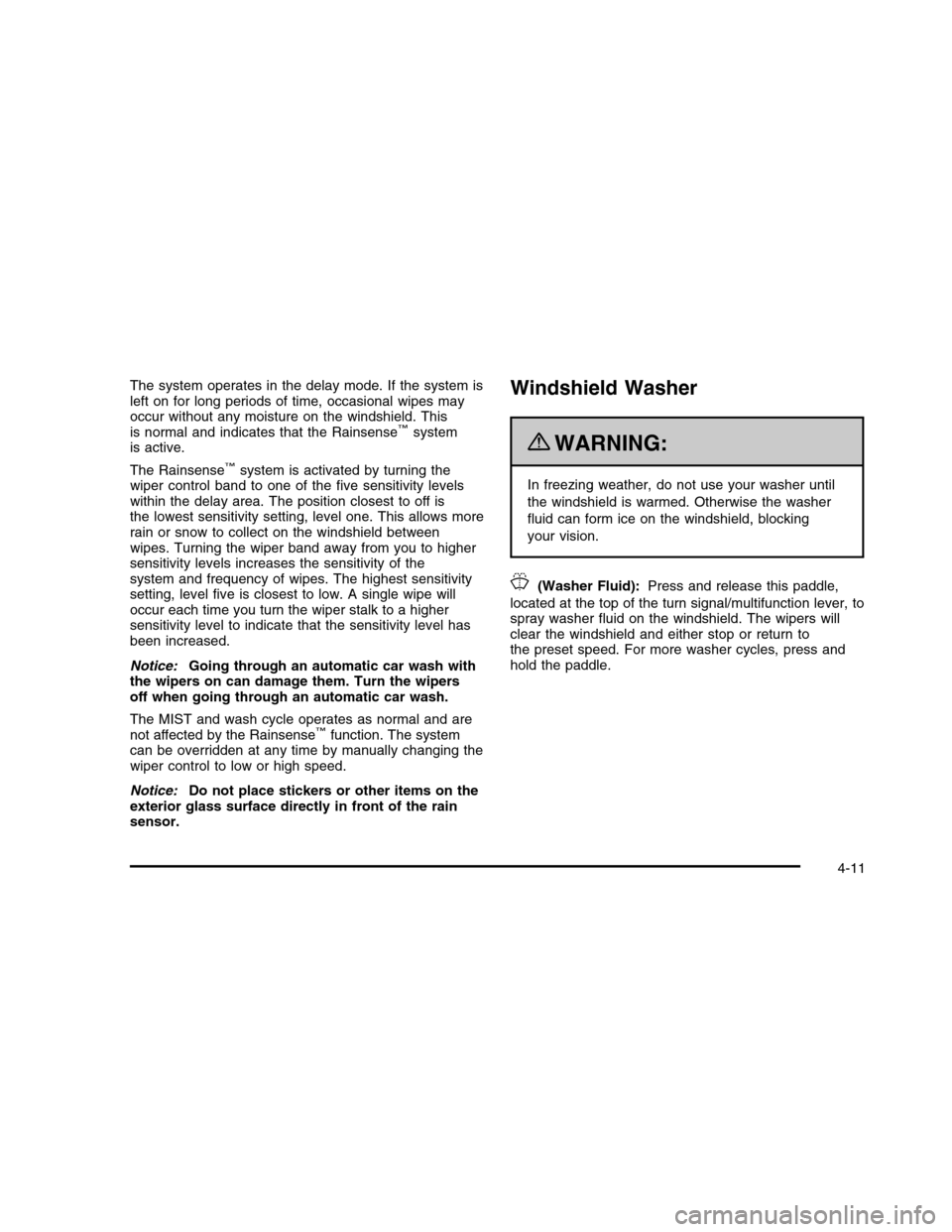CADILLAC DTS 2010 1.G Owners Manual
Manufacturer: CADILLAC, Model Year: 2010, Model line: DTS, Model: CADILLAC DTS 2010 1.GPages: 480, PDF Size: 17.56 MB
Page 171 of 480

Turn Signal/Multifunction Lever
The lever on the left side of the steering columnincludes the following:
G:Turn and Lane-Change Signals
23:Headlamp High/Low-Beam Changer
N:Windshield Wipers
L:Windshield Washer
Flash-To-Pass Feature.
Information for these features is on the pages following.
Turn and Lane-Change Signals
An arrow on the instrumentpanel cluster flashes in thedirection of the turn orlane change.
For vehicles with the side blind zone alert system, anarrow in the outside mirror flashes when the turn signalis used. SeeSide Blind Zone Alert (SBZA) onpage 3-43for more information.
Move the lever all the way up or down to signal a turn.
Raise or lower the lever until the arrow starts to flashto signal a lane change. Hold it there until the lanechange is complete. If the lever is briefly pressed andreleased, the turn signal will flash three times.
The lever returns to its starting position when it isreleased.
If after signaling a turn or lane change the arrow flashesrapidly or does not come on, a signal bulb may beburned out.
Have the bulbs replaced. If the bulb is not burned out,check the fuse. SeeFuses and Circuit Breakers onpage 6-101.
4-5
Page 172 of 480

Turn Signal On Chime
If the turn signal is left on, a warning chime sounds andthe Driver Information Center (DIC) will display TURNSIGNAL ON after driving about a mile as a reminder toturn it off. SeeDIC Warnings and Messages onpage 4-67.
Headlamp High/Low-Beam Changer
Push forward to change the headlamps from lowbeam to high. Pull the lever back and then release it tochange from high beam to low.
This light on the instrumentpanel cluster will be on,indicating high-beamusage.
Forward Collision Alert (FCA)
System
If your vehicle has this feature, be sure to read thisentire section before using it.
The system operates on a radio frequency subject toFederal Communications Commission (FCC) Rules andwith Industry Canada.
This device complies with Part 15 of the FCC Rules.Operation is subject to the following two conditions:
1. This device may not cause interference.
2. This device must accept any interference received,including interference that may cause undesiredoperation of the device.
This device complies with RSS-210 of Industry Canada.Operation is subject to the following two conditions:
1. This device may not cause interference.
2. This device must accept any interference received,including interference that may cause undesiredoperation of the device.
Changes or modifications to this system by other thanan authorized service facility could void authorization touse this equipment.
4-6
Page 173 of 480

The Forward Collision Alert (FCA) system provides anaudible and visual alert if you approach a vehicletoo quickly that is directly ahead. FCA also provides avisual alert with no audible alert if you are followinganother vehicle much too closely. The FCA alert symbolis located on top of the instrument panel to the rightof the driver. FCA uses the Adaptive Cruise Controlradar to detect a vehicle directly ahead, in your path,within a distance of 328 ft (100 m) and operates atspeeds above 20 mph (32 km/h).
{WARNING:
FCA is only a warning system and does not apply
the brakes. When you are approaching a vehicle
or object too rapidly or when you are following a
vehicle too closely that is ahead of you, FCA may
not provide you with enough time to avoid a
collision. FCA is not designed to warn the driver of
pedestrians or animals. Your complete attention is
always required while driving and you should be
ready to take action and apply the brakes. For
more information, seeDefensive Driving on
page 5-2.
The FCA control is locatedon the steering wheel.
To enable or disable FCA, press the Adaptive CruiseControl button. SeeAdaptive Cruise Control onpage 4-15.
4-7
Page 174 of 480

FCA is enabled when the green light on the button is lit.FCA is disabled when the indicator light is amber.
{WARNING:
•On winding roads, FCA may not detect a
vehicle ahead. You could crash into a vehicleahead of you. Do not rely on FCA onwinding roads.
•When weather limits visibility, such as in fog,
rain, or snow, FCA performance is limited.There may not be enough warning distance tothe vehicle in front of you. Do not rely onFCA in low visibility conditions.
{WARNING:
When FCA is enabled, the Adaptive Cruise
Control switch is on. If you press another Adaptive
Cruise Control button, you might go into cruise
when you do not want to. You could be startled
and even lose control. Be careful not to press
adaptive cruise buttons unless you want to use
cruise control.
Alerting the Driver
The FCA alert symbol willflash and a warning beepwill sound when driveraction may be required.
The alert symbol will flash when:
•Your vehicle is approaching another vehicle too
quickly.
•Your vehicle is following a vehicle ahead of you
much too closely.
SeeDefensive Driving on page 5-2for more information.
Detecting the Vehicle Ahead
The vehicle ahead symbol, located next to the FCAsymbol, will only appear when a vehicle ahead of you isdetected in your path. If this symbol does not appear,or disappears briefly, FCA will not respond to vehiclesyou may see ahead. The symbol may disappear oncurves, highway exit ramps, or hills. Also, when anothervehicle enters the same lane as you, the FCA systemwill not detect the vehicle until it is completely inyour driving lane.
4-8
Page 175 of 480

{WARNING:
When the Adaptive Cruise Control radar is blocked
by snow, ice, or dirt, it may not detect a vehicle
ahead. FCA may not help you avoid a collision
under these conditions. Do not use FCA when the
radar is blocked by snow, ice, or dirt. Keep your
radar clean. See “Cleaning the System” under
Adaptive Cruise Control on page 4-15.
{WARNING:
FCA may not detect and warn soon enough to
stationary or slow-moving vehicles or other objects
ahead of you. You could crash into an object
ahead of you. Do not rely on FCA when
approaching stationary or slow-moving vehicles or
other objects.
Unnecessary Alerts
FCA may occasionally provide alerts that you considerunnecessary. It could respond to a turning vehicleahead of you, guard rails, signs, and other stationaryobjects. This is normal operation, your vehicle does notneed service.
Other Messages
There are three messages that may appear on theDriver Information Center (DIC). They are CLEANRADAR, RADAR CRUISE NOT READY and SERVICERADAR CRUISE. SeeDIC Warnings and Messageson page 4-67.
Cleaning the System
The radar can become blocked by snow, ice, or dirt.If so, you may need to turn off the engine and clean thelens. See “Cleaning the System” underAdaptiveCruise Control on page 4-15.
4-9
Page 176 of 480

Flash-to-Pass
This feature lets you use the high-beam headlamps tosignal the driver in front of you that you want to pass.
The flash-to-pass feature will only work with theheadlamps on. It does not work with Daytime RunningLamps (DRL).
Pull and hold the turn signal lever toward you to use.
If the headlamps are on low beam, pulling the turn signaltowards you will flash the high beams.
Windshield Wipers
The windshield wiper lever is located on the left side ofthe steering column.
Turn the band with the wiper symbol on it to control thewindshield wipers.
8(Mist):For a single wiping cycle, hold it on mist
until the wipers start, then release. The wipers stop afterone wipe. Several wipes, hold the band longer.
6(Delay): Use to set the delay time between wipe
cycles. The wiper speed can be set for a long or shortdelay between wipes. The closer the band is set tothe top of the lever, the shorter the delay.
6(Low Speed):Slow wipes.
1(High Speed):Fast wipes.
9(Off):Turns the wipers off.
Clear ice and snow from the wiper blades before usingthem. If frozen to the windshield, carefully loosen orthaw them. Damaged blades should be replaced.
Heavy snow or ice can overload the wiper motor.A circuit breaker will stop the motor until it cools.
The vehicle has wiper-activated headlamps. After thewindshield wipers have completed eight wipe cycleswithin four minutes, the headlamps automaticallyturn on. SeeWiper Activated Headlamps on page 4-29for more information.
Rainsense™II Wipers
If the vehicle has this feature, the moisture sensor ismounted on the interior of the windshield besidethe rearview mirror and is used to automatically operatethe wipers. This system operates by monitoring theamount of moisture build-up on the windshield. Wipesoccur as needed to clear the windshield dependingon the driving conditions and the sensitivity setting. Inlight rain or snow, fewer wipes will occur. In heavyrain or snow, wipes will occur more frequently.
4-10
Page 177 of 480

The system operates in the delay mode. If the system isleft on for long periods of time, occasional wipes mayoccur without any moisture on the windshield. Thisis normal and indicates that the Rainsense™systemis active.
The Rainsense™system is activated by turning thewiper control band to one of the five sensitivity levelswithin the delay area. The position closest to off isthe lowest sensitivity setting, level one. This allows morerain or snow to collect on the windshield betweenwipes. Turning the wiper band away from you to highersensitivity levels increases the sensitivity of thesystem and frequency of wipes. The highest sensitivitysetting, level five is closest to low. A single wipe willoccur each time you turn the wiper stalk to a highersensitivity level to indicate that the sensitivity level hasbeen increased.
Notice:Going through an automatic car wash withthe wipers on can damage them. Turn the wipersoff when going through an automatic car wash.
The MIST and wash cycle operates as normal and arenot affected by the Rainsense™function. The systemcan be overridden at any time by manually changing thewiper control to low or high speed.
Notice:Do not place stickers or other items on theexterior glass surface directly in front of the rainsensor.
Windshield Washer
{WARNING:
In freezing weather, do not use your washer until
the windshield is warmed. Otherwise the washer
fluid can form ice on the windshield, blocking
your vision.
J(Washer Fluid):Press and release this paddle,
located at the top of the turn signal/multifunction lever, tospray washer fluid on the windshield. The wipers willclear the windshield and either stop or return tothe preset speed. For more washer cycles, press andhold the paddle.
4-11
Page 178 of 480

Cruise Control
With cruise control, a speed of approximately 40 km/h(25 mph) or more can be maintained without keepingyour foot on the accelerator. Cruise control does not workat speeds below about 40 km/h (25 mph). A cruise controllight appears in the instrument panel cluster when thecruise control is on.
When the brakes are applied, the cruise controlshuts off.
{WARNING:
Cruise control can be dangerous where you
cannot drive safely at a steady speed. So, do not
use the cruise control on winding roads or in
heavy traffic.
Cruise control can be dangerous on slippery roads.
On such roads, fast changes in tire traction can
cause excessive wheel slip, and you could lose
control. Do not use cruise control on slippery roads.
If your vehicle is in cruise control when the TractionControl System (TCS) begins to limit wheel spin,the cruise control automatically turns off. SeeTractionControl System (TCS) on page 5-6. When roadconditions let you safely use it again, the cruise controlcan be turned back on.
Setting Cruise Control
{WARNING:
If you leave your cruise control on when you are
not using cruise, you might hit a button and go
into cruise when you do not want to. You could be
startled and even lose control. Keep the cruise
control switch off until you want to use cruise
control.
4-12
Page 179 of 480

The cruise control buttonsare located on left side ofthe steering wheel.
I(On):Turns on the cruise control system.
+ RES (Resume/Accelerate):Press to make thevehicle accelerate or resume to a previously set speed.
SET– (Set):Press to set the speed.
[(Cancel):Press to cancel cruise control.
Cruise control will not work if the parking brake is set, orif the master cylinder brake fluid level is low.
If the brakes are applied, the cruise control shuts off.
The cruise light on the instrument panel cluster comeson after the cruise control has been set to the desiredspeed.
1. PressI.
2. Get up to the desired speed.
3. Press the SET– button located on the steeringwheel and release it.
4. Take your foot off the accelerator.
Resuming a Set Speed
Suppose the cruise control is set at a desired speedand then the brakes are applied. This shuts off thecruise control. But it does not need to be reset.
Once the vehicle is traveling approximately 40 km/h(25 mph) or more, press the +RES (resume/accelerate)button to return to the desired preset speed. Thecruise light displays again.
The vehicle returns to and stays at the preset speed. Ifyou press and hold the +RES button, the vehicle speedincreases until the button is released or the brake isapplied. Do not hold in the +RES button, if you do notwant the vehicle speed to increase.
4-13
Page 180 of 480

Increasing Speed While Using Cruise
Control
There are two ways to go to a higher speed:
•Use the accelerator pedal to get to the higher
speed. Press the SET– button, then releasethe button and the accelerator pedal. The vehiclenow cruises at the higher speed.
•Press the +RES button. Hold it there until the
desired speed is reached, and then releasethe button. To increase the vehicle speed in verysmall amounts, briefly press the +RES buttonand then release it. Each time this is done, thevehicle accelerates approximately 1.6 km/h (1 mph).
The accelerate feature only works after the cruisecontrol speed is set by pressing the SET– button.
Reducing Speed While Using Cruise
Control
There are two ways to reduce the vehicle speed whileusing cruise control:
•Press the SET– button until the lower speed
desired is reached, then release it.
•To slow down in very small amounts, push the
SET– button briefly. Each time this is done,the vehicle slows down approximately1.6 km/h (1 mph).
Passing Another Vehicle While Using
Cruise Control
Use the accelerator pedal to increase the vehicle speed.When you take your foot off the pedal, the vehicleslows down to the previous cruise control speed.
4-14